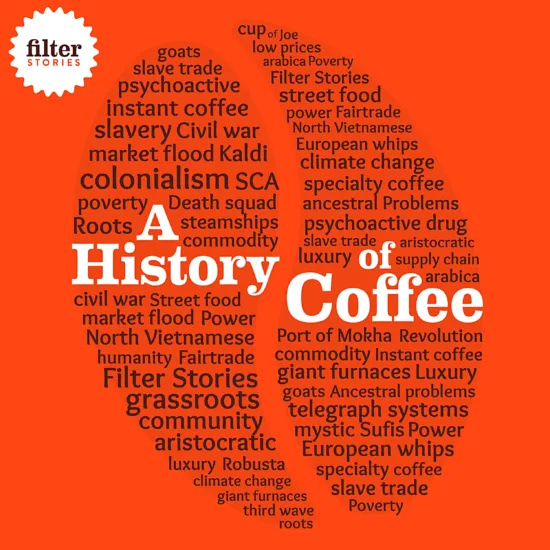[[{“value”:”
BY J. MARIE CARLANBARISTA MAGAZINE ONLINE
Featured photo courtesy of James Harper
James Harper is an Italian Australian podcaster and documentary audio producer. Last spring, he and his collaborator Jonathan Morris released the second series of their podcast, “A History of Coffee.” Jonathan Morris is professor of Modern History at the University of Hertfordshire, UK, associate professor at the MUMAC Academy in Milan, and author of Coffee: A Global History.
Starting Out
James says the “History of Coffee” partnership with Jonathan began during the early days of the COVID-19 pandemic, when he had returned to Italy to stay with his parents. “I was sitting in the garden, and I had with me Jonathan Morris’ book Coffee: A Global History, which I was really enjoying. I was like, wow, this is so vivid, so many stories, busting myths left, right, and center. I was like, I have to make a podcast about this.“
So James emailed the professor, and the rest is (coffee) history. “Jonathan is extremely knowledgeable, and a critical thinker,“ James says of his collaborator and friend. “There were so many moments where my understanding of coffee was just torn to shreds, in a good way. … The rigor with which he approaches source material, I found it a great learning experience.“
’Filter Stories’ and Series One
This is not James Harper’s first foray into the world of coffee podcasting. He began with “Filter Stories“ in 2017; the “Filter Stories“ podcast tells the tales behind your cup of coffee, covering a wide range of topics, from a barista battling misogyny in her North Carolina shop to the connection between Trump’s proposed border wall and coffee from El Salvador. To create the first series of the podcast, James spent six weeks immersed in Spanish while interviewing coffee farmers on a trip through Central America, starting with Guatemala. “I would interview them, record what they said, and then in the evenings transcribe it word for word,“ James says.
The addition of Professor Morris for the history podcast adds depth and sparkle. The two carry on an engaging conversation throughout, often with James asking questions and Jonathan rapid-firing expert answers. The first series of “A History of Coffee“ begins with the discovery of coffee, and its subsequent episodes go more or less in chronological order, following coffee as it spreads across the world, and its subsequent effects on the lives it touches.
Delving Deep Into Coffee’s History
The second series of “A History of Coffee“ was sponsored by espresso machine manufacturer Rancilio. “They have a museum and a lot of history, and they’re embedded in Italian culture,“ James says, “so it was an ideal partnership.“ For this series, Jonathan and James decided to go a different route. They had been forced to cut out lots of information for the sake of brevity on the first go-round, and some incredible stories were glossed over, as there simply wasn’t room for everything they wanted to explore. So for the second series they approached the topics differently. “This time instead of being a chronology of coffee from the early days in Ethiopia all the way through today, we’ll pick one theme and just go deep in it every episode,“ James explains.
This approach allowed James and Jonathan to give the audience a feel for what people experienced during those often tumultuous times. They don’t shy away from gritty details; many of the stories reflect on the violence, exploitation, and human rights abuses involved in coffee’s long history. For example, James’ favorite episode of the podcast’s second series is the second one, called “A Lasting Stain: Haiti, Colonialism, and Coffee.“
“I’m very proud of it for many reasons,“ says James. “It’s a hard story, partly because of the complexity of it … beginning with the French and Haitian revolutions happening together, which are both extremely messy and hard to untangle.“ For this episode, James begins by asking Jonathan what you would see if you were a drone flying above the island at different times in history. It’s an effective way to help the listener visualize the swift changes from the pre-colonial (and pre-coffee) era to the destruction that would come later. “So you frame it, and once you have the frame you can go into the details. It’s very powerful. Jonathan did an extraordinary job bringing that to life,“ James says.
Looking Ahead
If you attended the Specialty Coffee Expo this year, you may have seen James and Jonathan presenting a lecture titled “Cheap Coffee: A History.“ This lecture centered on how coffee went from the equivalent of over $30 a cup to today’s $3 a cup—an important consideration, as the specialty-coffee industry continues to struggle with improving wages for coffee producers.
The duo hope to begin work on a third series of “A History of Coffee.” Until then, we can indulge in the “Filter Stories“ podcast, and James’ podcast “The Science of Coffee,“ both of which, lucky for us, are ongoing.
ABOUT THE AUTHOR
J. Marie Carlan (she/they) is the online editor for Barista Magazine. She’s been a barista for 15 years and writing since she was old enough to hold a pencil. When she’s not behind the espresso bar or toiling over content, you can find her perusing record stores, writing poetry, and trying to keep the plants alive in her Denver apartment. She occasionally updates her blog.
Subscribe and More!
Out now: It’s the April + May 2024 issue of Barista Magazine! Read it for free with our digital edition. And for more than three years’ worth of issues, visit our digital edition archives here.
You can order a hard copy of the magazine through our online store here, or start a subscription for one year or two.
“}]]


